What exactly are Cicadas?
By Zachary Ciras on August 4, 2022.
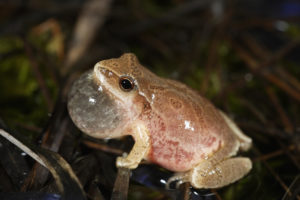
A spring peeper peeping
The crack of the bat, the roar of the crowd, the buzz of the cicadas, and the peep of the chorus frog… These are the sounds of summer in New England. Cicadas occupy a sub-group of Hemiptera called Homoptera. Hemiptera are the “true bug” group and consists of leafhoppers, aphids, cicadas, bed bugs, and shield bugs for example. Hemiptera insects, or bugs, share a similar arrangement of piercing sucking mouthparts, nymphs that somewhat resemble their adult counterparts, and undergo incomplete (hemimetabolous) metamorphosis with egg, nymph, and adult stages. Notable bugs in Homoptera include cicadas, scale insects, and aphids. These bugs feed primarily on the fluids from plants. Scale insect and aphids are known to cause damage to crops, and have been written about as being an agricultural pest for centuries. Cicadas may cause some plant damage while ovipositing, but are not generally considered an agricultural pest.
Female cicadas deposit hundreds of eggs into slits they’ve made into stems of grasses and weeds, and sap tree twigs of broadleaf trees. Up to 400 eggs can be deposited by a female. The 1st stage of nymph hatches in 6-7 weeks and then drops to the ground, buries itself anywhere from 2 inches to 2 feet under the soil, and grows slowly, sustaining itself on the plant juices (xylem) from roots. While the 17 & 13 year cicadas make the headlines as they emerge, the most common cicadas we hear (and sometimes see) is the Dog Day Cicada, Neotibicen canicularis. The Dog Day harvest fly or heat bug as this common cicada is sometime known, has a near-black to brown body with green and sometimes red marking, while its wings are interlaced with green veins. These annual cicadas actually can take up to 4 years of growth underground before they emerge.
The anatomy of a cicada
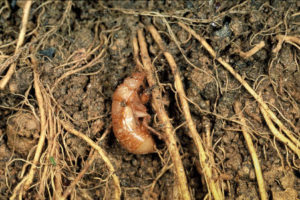
Annual (dogday) cicada nymph (Tibicen canicularis) attached to underground tree root. Nymph sucks sap from the root until it is ready to crawl to surface and change into an adult.
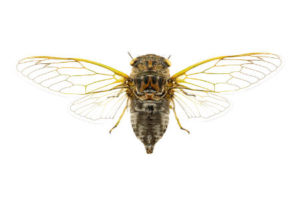
Mounted dog-day cicada from an insect colelction
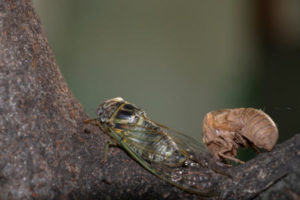
A dog day harvest fly or heatbug near to its shell. Neotibicen canicularis.
An adult cicada, like all insects, consists on the head, thorax, and abdomen, and six jointed legs. Unlike bees, wasps, and ants found in Hymenoptera, cicada segments are not distinct with the thin waist, but may look closer to one solid body. They have two pairs if wings, with the forewings being the larger of the two pairs, and large, compound eyes. They have short bristled antennae. Colors may vary from insect to insect, species to species. Massachusetts has 9 cicada species. Eight of these species are annual, and one is the The egg is small and rice shaped. These eggs are deposited into the slits the females make into the stems and twigs of plants.
What’s that noise?
Cicadas make a very distinctive humming noise, and it is the males making the raucous ruckus. Females do not possess the anatomy to generate the distinctive acoustic cacophony. Females and males of some species produce sound from wing flicking which results in a sort of click sound. Stridulation may also be a source of the vibrations ion some species when one part scrapes against stridulatory ridges on the pronoun (behind the head). However, the signature sound is produced via special organs called tymbals. Only male cicadas have these organs, and they vibrate these songs to indicate a variety of different expressions including alarm calls, mating calls, territory calls, and more. Some say the high pitched tremelo is reminiscent of a power saw. In fact, one species of cicada in Africa, Brevisana brevis, has been recorded from 20 inches away at 107db. A chainsaw is only 3db higher at 110 decibels! These are considered to be the loudest insects on earth.
Cicadas in the News
In 2021, Brood X Cicadas made national headlines as they emerged through many midwest and southeastern US states including New York and Washington DC. These two areas are epicenters of news generation, so it makes sense that impressive numbers of bugs emerging and appearing in front of their cameras would get covered everywhere. Massachusetts residents can expect to see the 17 year cicadas emerge in 2025 as they did in 2008.
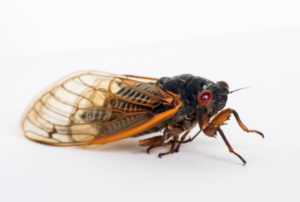
Dying Brood X Cicada Close Up
Brood X in 2021 will revisit in 2038. While it was present in 2021, news stories could be found ranging from simple scientific explanations to recipes on how to prepare the preponderance of protein seemingly falling from the sky. The periodical cicadas are smaller in size, ranging on average between 3/4″ to 1 1/4″ long, while annual cicadas are generally 1 3/4″. Periodical cicadas are usually darker, with black bodies, red eyes, red legs, and red veined wings. Cicada recipes Search – Bon Appetit!
Although the numbers may be impressive, and people have been mistakenly calling cicadas, especially periodical cicadas, locusts for centuries, they are not in fact the large, crop-destroying grasshoppers warned about since before the time of Moses. Some small plants and young trees may sustain some damage due to their feeding, but these are not likely to cause major economic damages or crop failure. See Cicadas Won’t Eat Your Plants
Cicada Killer Wasps
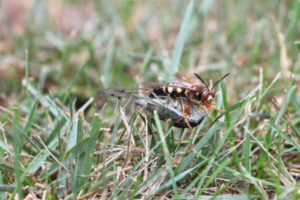
Cicada killer dragging a cicada in grass.
Cicadas have many natural predators from birds mites to fungus. One tactic to protect against catastrophic predation is to enact predator confusion by emerging in large numbers. This tactic results in a confusing bottleneck which makes it tough to select an individual prey. When individuals are taken, the large numbers left can still be prolific in reproducing among the gene pool.
One of the most visible predators we encounter is the Eastern Cicada Killer Wasp, Sphecius speciosus. This large wasp is intimidating, but harmless unless you’re a cicada. They dig in largely sandy soil, bring a paralyzed cicada into the hole, an deposit eggs into the living bug for the larvae to feed on when they emerge. As brutal as it may sound if you’re a cicada, they pose no real threat to humans besides instilling fear in some less acquainted. See also The Biggest, Baddest Looking Wasps In New England
Treatment for Cicada Killer Wasps can be performed by lisenced professional pest control technicians, but long term control should be considered. Enriching the soil, especially near sandy spot such as walkways, pools, leech fields, and poles, should be considered. Strong grass roots systems should be encouraged, and running water over or placing a tarp over areas where these wasps are digging may remove them from the areas as well.
For more on cicadas from true Homoptera fans, visit Cicada Mania